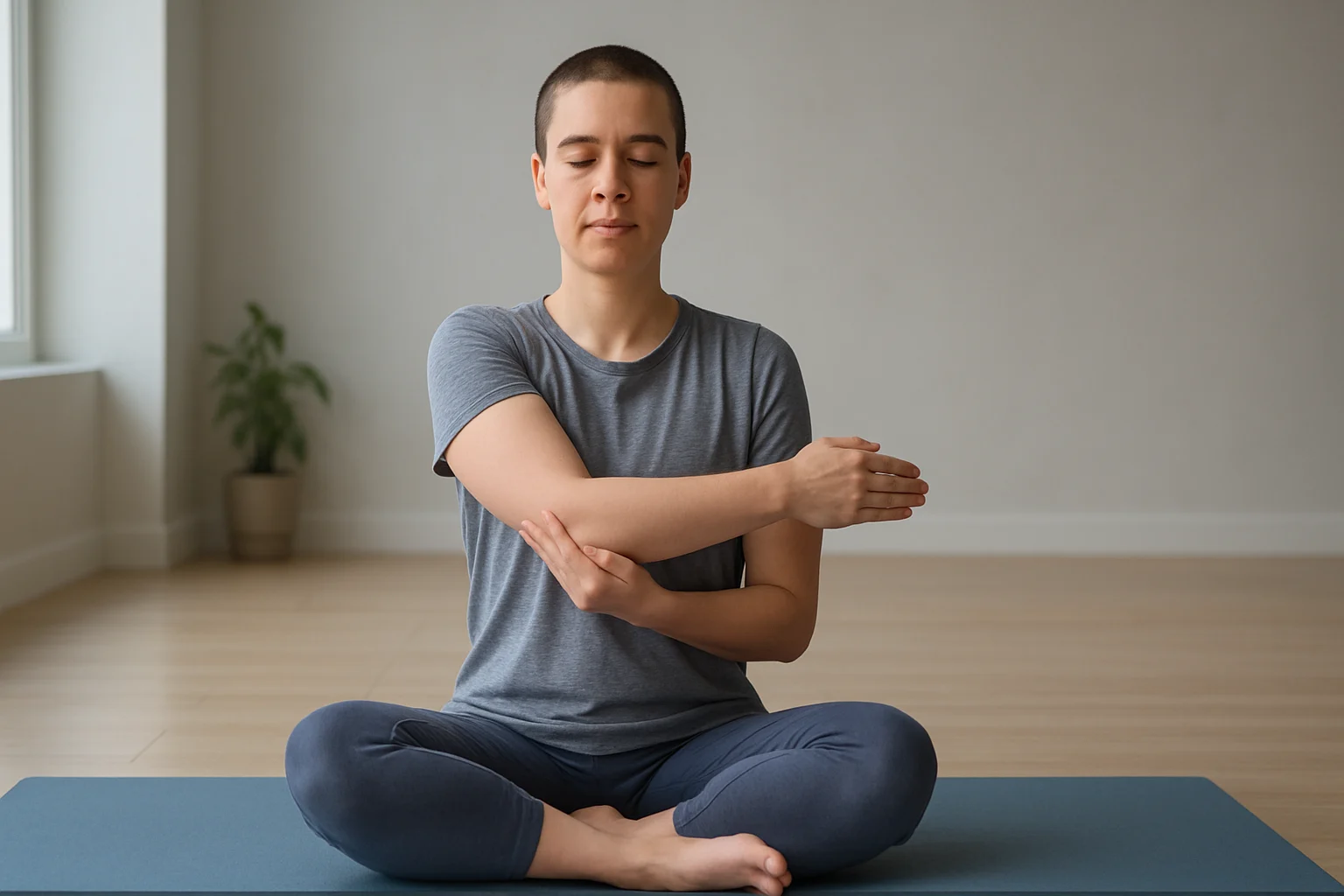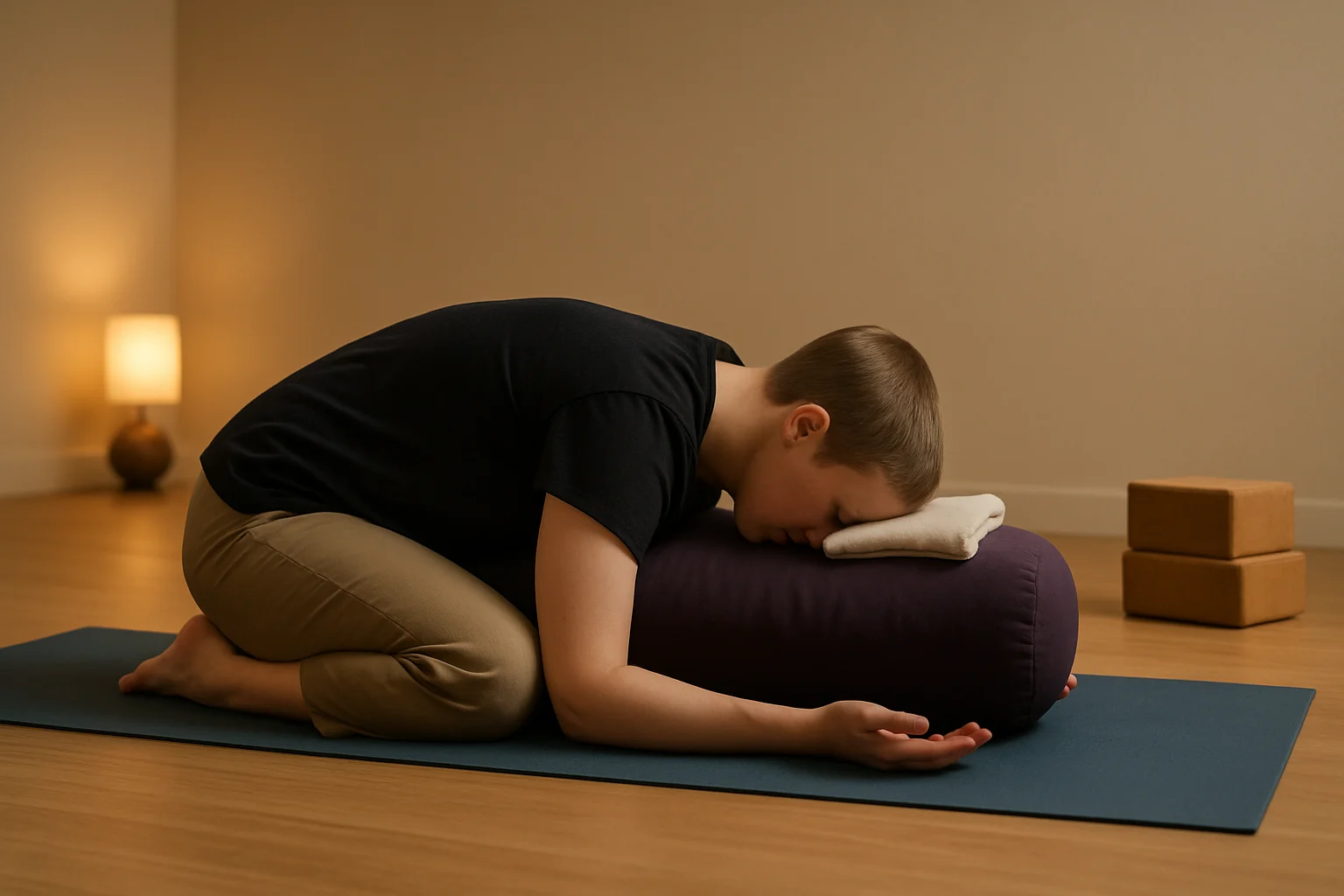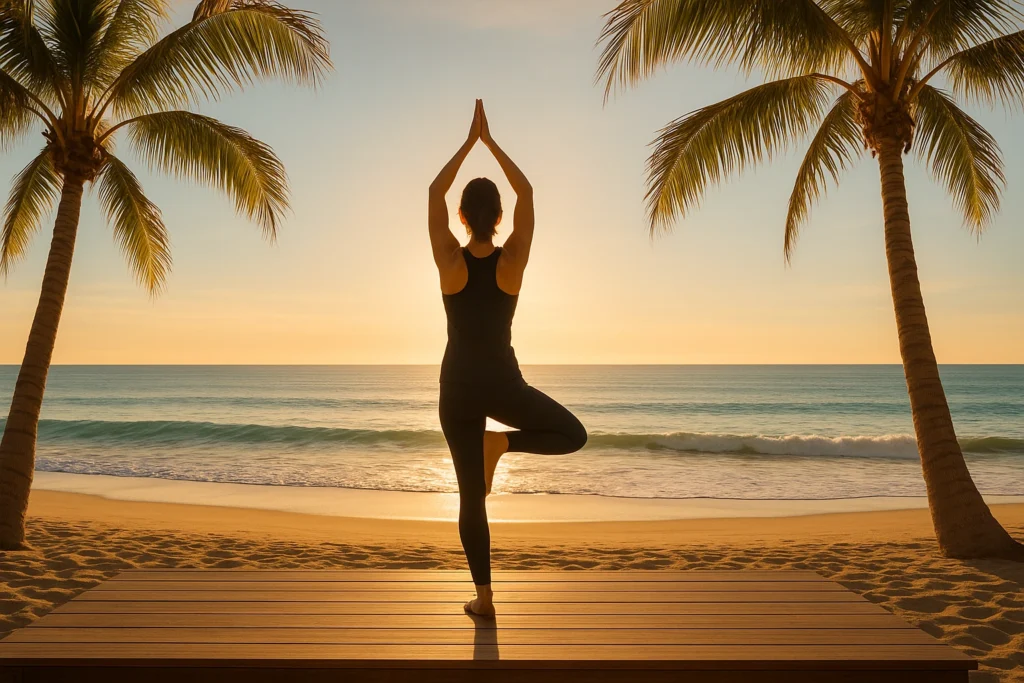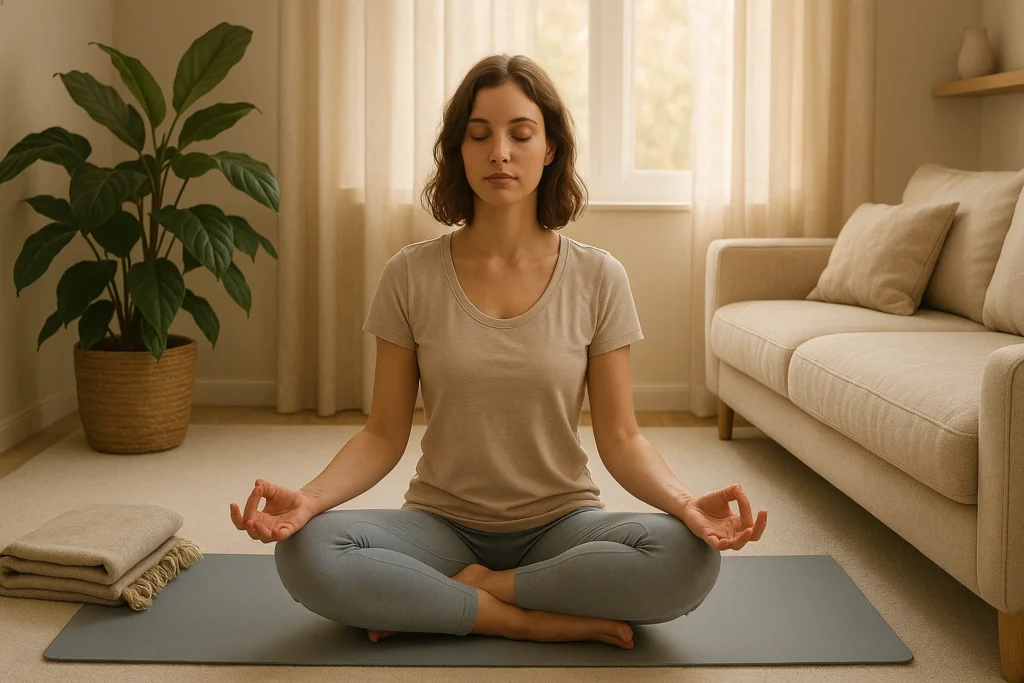
Struggling with a rotator cuff injury? This yoga rotator cuff guide may help you rebuild shoulder stability and ease discomfort with a few simple, gentle tweaks. You’ll see how mindful breathing and small, careful poses can support healing. For more options, explore our guide on yoga for specialized health to round out your recovery plan. 🧘♀️
Find Your Perfect Yoga PoseTable of Contents
- Key Takeaways for Shoulder-Friendly Yoga
- Understanding Your Rotator Cuff
- Key Benefits for Shoulder Recovery
- When to Start Safely
- Golden Rules for Safe Shoulder Yoga
- Gentle Poses for Healing Shoulders
- Find Your Best Starting Pose
- Poses to Avoid or Modify
- Building a Consistent Yoga Practice
- Mindfulness and Pain Management
- Real Stories of Recovery
- Frequently Asked Questions
- Quick-Reference Pose Guide
- Your Path to Stronger Shoulders
Key Takeaways for Shoulder-Friendly Yoga
- Consult Your Doctor First: Always get clearance from your healthcare provider before starting any new exercise program, especially after an injury.
- Listen to Your Body: Pain signals “stop.” Avoid pushing into discomfort during yoga rotator cuff recovery.
- Focus on Gentle Movement & Stability: Gradually restore range of motion and build shoulder stability, not advanced poses.
- Modify Everything: Use props and adjust poses to protect your shoulders.
- Patience is Key: Healing takes time. Be consistent and kind to yourself.
Understanding Your Rotator Cuff: A Quick Overview
Before exploring yoga, let’s quickly define the rotator cuff: four shoulder-stabilizing muscles—supraspinatus, infraspinatus, teres minor, and subscapularis—and their tendons. Together they:
- Lift your arm: Like reaching for a high shelf.
- Rotate your arm: Like turning a doorknob.
- Stabilize the joint: Keeping your arm bone centered in the shoulder socket.
When these tendons get irritated or torn (impingement or a partial tear), the shoulder often feels weak, sore, and tight. It’s usually from lots of overhead use, a slip or fall, or simple wear over time. For a deeper look, see Mayo Clinic’s guide.
Yoga Rotator Cuff: Key Benefits and How It May Help
If you’re worried yoga is too much right now, small tweaks make it doable—and surprisingly helpful:
- Improved Flexibility: Gentle stretches ease stiffness and restore range of motion.
- Gradual Strengthening: Controlled movements build shoulder and stabilizing muscles.
- Body Awareness: Yoga helps you tune into your shoulder’s limits, preventing re-injury.
- Pain Management: Breathing techniques may help reduce stress and shift pain perception, as explored in our guide on yoga and breathwork for stress relief.
- Better Posture: Core strength and spinal alignment reduce shoulder strain.
- Stress Relief: Yoga’s calming effects ease the emotional toll of recovery.
“Yoga isn’t just about stretching your muscles; it’s about stretching your mind and finding peace within your healing body.” 💖

Safety First: When to Start Yoga Rotator Cuff Practice
Before beginning, consult your doctor or physical therapist. They can confirm whether your shoulder is ready for movement, point out motions to avoid, and clarify where you are in recovery (acute, early rehab, or strengthening). Starting too soon can set you back. Once cleared, a shoulder-friendly yoga practice can complement prescribed exercises, similar to the tailored routines in our recovery yoga guide. If you’re practicing shoulder injury yoga at home, start with short sessions and stop at any sharp pain.
This post has affiliate links. We may earn a commission. Learn more.
Golden Rules for Safe Shoulder Yoga Practice
For a practice that feels safer and may help, keep these in mind:
- No Pain, No Strain: Pain = pause. Gentle stretch is fine; sharp, pinchy, or catching pain is your stop sign.
- Slow and Controlled: Move slowly and smoothly—quick, jerky motions tend to irritate the joint.
- Honor Your Limits: Work with today’s range, not yesterday’s goals.
- Modify Generously: Use props like blocks or chairs to reduce strain, as detailed in our essential yoga props guide.
- Breathe Deeply: Conscious breathing calms your nervous system.
- Engage Your Core: A strong core supports your shoulders.
- Stay Consistent: Small, regular efforts yield big results over time.
Gentle Yoga Rotator Cuff Poses for Healing Shoulders
These gentle yoga rotator cuff poses prioritize pain-free movement to support your shoulder’s recovery. In rotator cuff yoga, it’s normal to keep reps low and ranges small at first. Always move within your comfort zone.
Breathing and Awareness Warm-Up
Start by connecting with your breath to relax and focus.
- Diaphragmatic Breathing: Sit or lie down. One hand on your chest, one on your belly. Breathe in through your nose and let the belly lift; breathe out through your mouth and let the ribs soften. Continue for 5–10 minutes to help your body unclench.
Gentle Warm-Up Poses
These poses wake up your spine and shoulders without strain.
- Modified Cat-Cow (Marjaryasana-Bitilasana): On all fours, place forearms on the floor if hands are painful. Inhale, arch your back, and look up (Cow). Exhale, round your spine, tucking your chin (Cat). Repeat 5–10 times, flowing with breath.
- Gentle Neck Tilts: Sit tall. Tilt your right ear toward your right shoulder, hold for a few breaths, then roll your chin to your chest. Repeat on the left. Avoid full circles. Do 3–5 tilts per side.
Mobility & Gentle Strength for Shoulder Injury Yoga
These poses restore range of motion and engage stabilizers.
- Thread the Needle (Modified): On all fours, lift your left arm slightly, then thread it under your body, resting your left shoulder on a blanket if needed. Focus on upper back rotation. Hold 5–10 breaths, then switch sides.
- Supported Child’s Pose: Kneel, fold forward, and rest your torso between your thighs. If reaching forward tugs at the shoulder, rest your arms by your sides or onto blocks. Stay 1–2 minutes and let the breath be easy.
- Wall Slides/Angels: Stand with your back to a wall, feet a few inches out. Bend elbows to about 90°, forearms up like a goalpost. Glide the arms up and down within a comfy range, keeping light contact with the wall. Do 8–12 reps.
- Doorway Stretch: Place your forearms on the doorframe with elbows just below shoulder height. Step one foot forward until you feel a light chest stretch. Hold 20–30 seconds; repeat 2–3 times.
- Seated Chair Poses:
- Seated Mountain: Sit tall, feet flat, shoulders back. Focus on posture for 5 breaths.
- Seated Spinal Twist: Place right hand on left knee, left hand on chair back. Twist gently to the left. Hold 5 breaths, then switch.
- T-Spine Rotation (Open Book): Lie on your side, knees bent, arms extended. Open your top arm like a book, letting it rest as far as comfortable. Repeat 5–8 times per side.
Later-Stage Strengthening Poses
Use these only with your clinician’s OK, once pain is controlled and basic mobility feels good.
- Scapular Push-Ups (Wall/Tabletop): Against a wall or on all fours, keep elbows straight. Squeeze shoulder blades together, then push apart. Repeat 8–12 times, focusing on blade movement.
- Wall Plank: Place hands on a wall, lean in, keeping a straight body. Hold 20–30 seconds, 2–3 times, adjusting distance for comfort.
- Modified Warrior II: Stand with feet wide, front knee bent. Keep hands on hips or extend uninjured arm. Hold 5–8 breaths, then switch.
Cool-Down and Relaxation
End with relaxation to integrate benefits.
- Supported Savasana: Lie back with a pillow under your head and another under the arm for support. Settle for 5–10 minutes and let the breath be easy.
Find Your Best Starting Pose
Answer three quick questions to get a gentle, shoulder-friendly starting point:

Poses to Avoid or Modify Heavily
Some shapes load the shoulder more than you need right now—treat these with caution or skip them:
- Weight-Bearing Poses: Full Plank, Downward Dog, Chaturanga, Handstand, Crow.
- Deep Stretches: Cow Face, Eagle Pose, intense binds.
- Overhead Reaches: Warrior I, Upward Salute (if uncontrolled).
- Repetitive Flows: Fast sun salutations or Chaturanga-heavy vinyasa.
When in doubt, skip or consult a yoga therapist.
Building a Consistent Yoga Practice
Consistency trumps intensity for recovery.
- Start Small: For rotator cuff yoga, practice 10–15 minutes, 2–3 times weekly.
- Progress Gradually: Increase duration as strength improves.
- Adjust Daily: Adapt based on how your shoulder feels.
- Seek Expert Guidance: A yoga therapist can tailor modifications, as outlined in our yoga teacher training guide.
- Track Progress: After each session, note what felt good and what didn’t so you can spot patterns over time.
Mindfulness and Pain Management
Beyond poses, yoga’s holistic tools aid recovery:
- Mindfulness: Pay attention to sensation without judging it—it often eases anxiety (more in our mindfulness for recovery guide).
- Meditation: Try a 5-minute guided practice to dial down pain perception.
- Affirmations: A simple line like “My body is healing” can help steady your mindset.
Real Stories of Recovery
Real voices, real recoveries—here’s how others brought yoga into shoulder rehab:
- Maria, 55: After a partial rotator cuff tear from a fall, Maria hesitated to try yoga. “My therapist recommended gentle movements, and my instructor taught me Child’s Pose with arms by my sides. After six months, I could lift my grandkids with less pain. Breathing helped me stay calm.”
- David, 40: A tennis player post-surgery, David found wall slides and scapular push-ups transformative. “I thought yoga was just stretching, but it strengthened my shoulder blades, helping me return to the court stronger.”
- Sarah, 28: A swimmer with impingement, Sarah used modified Warrior II. “Keeping my arms low and focusing on my core made a big difference. I’m back to swimming with confidence.”
Frequently Asked Questions About Yoga for Rotator Cuff
Quick-Reference Pose Guide
| Pose | Purpose | Modification |
|---|---|---|
| Diaphragmatic Breathing | Relaxes nervous system | Sit or lie comfortably, focus on belly rising |
| Modified Cat-Cow | Warms up spine | Use forearms or chair if hands hurt |
| Thread the Needle | Improves mobility | Use blanket, limit arm movement |
| Supported Child’s Pose | Relaxes shoulders | Arms by sides or on blocks |
| Wall Slides/Angels | Builds stability | Move only in pain-free range |
Your Path to Stronger Shoulders
During rotator cuff recovery, a gentle yoga practice can help you heal mindfully. With your clinician’s guidance, patient progress, and consistent, controlled movement, you’ll rebuild strength and mobility. Every gentle stretch is a step toward strength. Celebrate the small wins—your shoulders are on their way. 🙏


